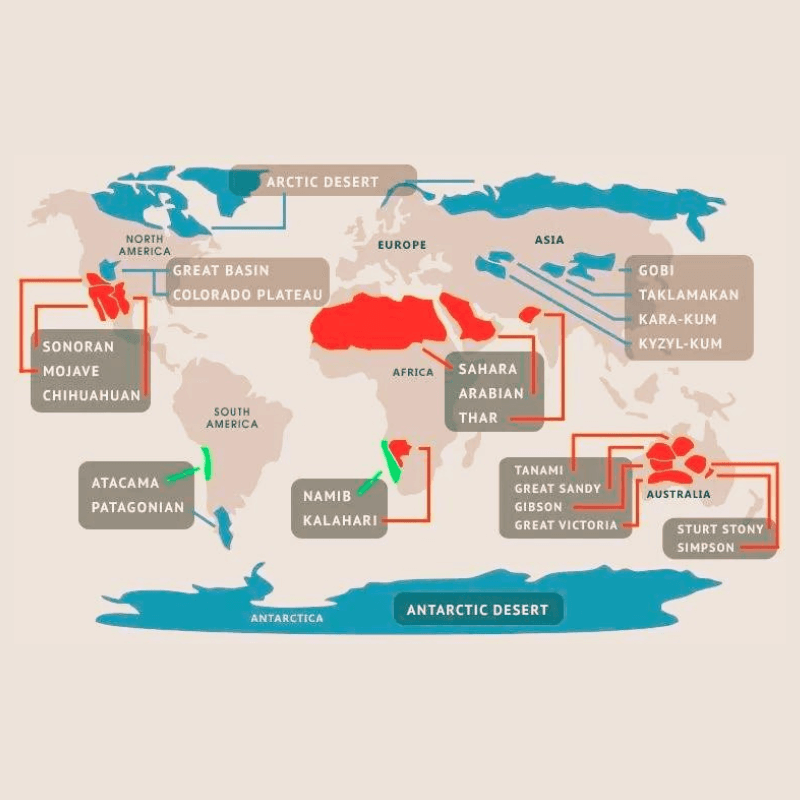
In cold desert regions in India, the expanse of deserts appears to be growing because of deglaciation or progressive melting of glaciers due to climate change”, experts have warned.
In order to understand different aspects of this phenomenon, more in-depth research studies are needed and local communities should be encouraged to take up adaptation measures.
Also read: World Climate: Types and its Characteristics
What are Cold deserts?
- A cold desert is an arid habitat with an annual rainfall of less than 25 cm. They have a temperate climate with scorching summers and chilly winters because they are situated at a high latitude in the interior of the continent.
- Here weather and soil are not suitable for plant growth. Hence land is bereft of vegetation except for isolated, scattered and overgrazed herbaceous shrubs.
- The grazing period is less than 3-4 months and it is mainly during the hot season only.
- It generally occurs in Ladakh, Leh and Kargil areas of Kashmir and the Spiti valley of Himachal Pradesh.
Also read: Deserts of the world
Classifications
- Dry temperate zone: Vegetation includes – Betula utilis, Salix spp, Juniperus recurva
- Alpine Zone: Vegetation includes – Junipers, Birch, Rhododendron with grass
- Perpetual snow zone: No vegetation due to permanently frozen soil

The distribution of cold deserts is depicted on the map. Some of them are
- North America – Great basin
- South America – Atacama Desert, Patagonian desert
- Eurasia – Iranian desert, Gobi desert, Turkestan
- Africa – Namib Desert
Characteristics of Cold Deserts
- Most of the time, the temperature is below zero degrees Celsius, which prevents plants from absorbing water.
- Due to the extremely dry atmosphere and low mean annual rainfall (less than 400 mm), the area has a desert-like characteristic.
- Snowfall is heavy and occurs between late November and early April.
- Wind erosion is more common.
- Soil is sandy to sandy loam and neutral to sight alkaline in nature.
- Soil has poor organic matter content and low water retention capacity.
- The growing period is narrow which is mostly during the summer season.
Also, read Desertification.
Challenges related to Cold deserts
- While certain disasters (such as earthquakes) might happen instantly, others (such as tornadoes) can take hours, months, or even years to materialize. According to how they begin, environmental hazards and associated natural disasters are divided into two groups:
- Disasters with a slow start, like drought or desertification, develop gradually, making it challenging to predict when they will start and stop. There is no single indicator or index that can accurately pinpoint the beginning and severity of the event; the duration might range from months to years. The effects are typically non-structural and challenging to measure.
- Drought occurrences, which can be categorised as meteorological, hydrological, or agricultural droughts, occur when there is insufficient water to meet the regular needs of agriculture, cattle, industry, or the human population.
- Desertification takes place on bigger time- and space scales. Additionally, because of their possible length of time, the focal point frequently changes over time, necessitating ongoing monitoring of climate and water supply indicators.
- Rapid-onset disasters are defined by the impacts’ suddenness and acute intensity over a brief period of time. The loss of lives and property caused by a specific disaster event is typically used to measure the severity of rapid-onset disasters. Rapid-onset catastrophes do not allow individuals enough time to reduce the danger of an event happening because of the way they start.
- The Himalayan region is extremely vulnerable to rapid-onset hydrologic, meteorological, and geologic disasters because of its fragility, geo-tectonic features, and extraordinary susceptibility to climate change. Due to the area’s remoteness and accessibility, it is difficult to respond in a timely manner, and the lack of a thorough understanding of its natural dynamics makes it difficult to take precautions or issue alerts or early warnings.
- Geo-physical Disasters: They come from events or natural earth processes. The term “geological hazard” refers to both geomorphic processes such as mass movements like landslides, rockslides, rock falls, avalanches, the surface collapses, etc. as well as internal earth processes of tectonic origin, such as earthquakes, geological fault activity, tsunamis, and volcanic activity.
- The mass movements occurring at a greater pace are more dangerous e.g. rock falls, which often occur without any warning.
- Drought frequency is rising due to global warming, which dries up water holes. The frequency of wildfires that change desert landscapes by destroying slow-growing trees and shrubs and replacing them with quickly-growing grasses may increase as temperatures rise.
- The low adaptive capacity of the socio-ecological system.
Way Forward
It can be challenging to try to stop desertification in some situations. Research and technological developments that push the boundaries of what we currently know is required under certain circumstances. We might discover more strategies to avert the devastation it brings about, thanks to advancements.
The worrying trend is the increase in desertification and expansion of both types of deserts. Natural causes for desert formation have been from times immemorial, it is the anthropogenic causes that are a cause of concern. The plan of action to combat desertification needs to be in line with the UN Convention to Combat Desertification (UNCCD).
Article Written by: Remya





Leave a Reply